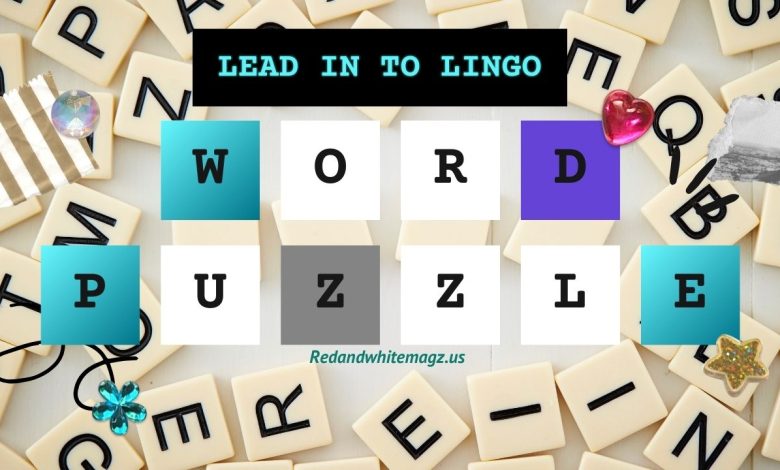Word Chain Adventure: Exploring Lead in to Lingo

Lead in to lingo is a fun puzzle game where you find connections between words. Each word gives a clue. You use these clues to guess the next word.
It’s like a word chain where each link is important. For example, if the clue is “cat,” the next word might be “kitten.”
This game helps improve your vocabulary and thinking skills. It’s a great way to learn new words while having fun. You can play it alone or with friends.
Just start with one word and see where it leads you. Enjoy the challenge and have fun exploring words!
Introduction to the Concept
What is “Lead in to Lingo”?
“Lead in to Lingo” is a puzzle game where players find connections between words. It starts with a single word, and players use it to guess the next word. Each word acts as a clue for the following one. This game is fun and educational. It helps improve vocabulary and critical thinking skills.
How is this Game Structured?
The game is structured as a word chain. Players begin with an initial word. They then think of a word that logically follows.
For example, starting with “sun,” the next word might be “shine.” Each word must relate to the previous one. This creates a continuous chain of words.
What are the Basic Rules of the Game?
The basic rules are simple. Start with a given word. Use it to find a connected word. Continue this pattern to create a word chain. Each word must be a logical step from the previous word. There are no strict time limits. Players can take their time to think. The game can be played alone or with friends.
“Lead in to Lingo” is a fun way to learn new words and think creatively. It’s suitable for all ages, making it a perfect family game. Enjoy building word chains and exploring new connections!
Understanding the Mechanics
How Do You Use the Initial Word to Find the Next Word?
In “Lead in to Lingo,” start with an initial word to find the next word. Think about what logically follows. For example, if the word is “apple,” the next word might be “fruit.” This connection makes sense because an apple is a type of fruit.
What Types of Clues Are Typically Given?
Clues are usually simple and related to the word’s meaning. They can be synonyms, antonyms, or words commonly associated. For example, a clue for “cat” might be “pet” or “kitten.” These clues help players think of related words.
How Does Each Word Connect to the Next One?
Each word connects to the next through a logical relationship. For instance, “sun” connects to “shine” because the sun shines. These connections form a chain that makes sense. The game continues this way, with each word linking to the next.
“Lead in to Lingo” uses easy clues to create fun and educational word chains. Players build connections, enhancing vocabulary and thinking skills.
Educational Benefits
How Does “Lead in to Lingo” Help Improve Vocabulary?
“Lead in to Lingo” helps improve vocabulary by introducing new words and their meanings. As players find connections, they learn synonyms, antonyms, and related terms. This game expands their word knowledge in a fun way. It encourages them to think about how words relate to each other.
What Critical Thinking Skills Are Enhanced by Playing This Game?
Playing “Lead in to Lingo” enhances critical thinking skills. Players must think creatively to find connections between words. They develop problem-solving abilities by considering different possibilities. This game also improves logical thinking, as each word must make sense in the sequence.
How Can This Game Be Used in a Classroom Setting?
In a classroom setting, “Lead in to Lingo” can be a valuable educational tool. Teachers can use it to make learning new words engaging. It can be played in groups to promote teamwork and communication. The game can also be used as a warm-up activity or a fun break during lessons.
“Lead in to Lingo” combines learning and fun, making it perfect for educational environments. It enhances vocabulary and critical thinking skills while keeping students engaged.
Playing the Game
What Are Some Strategies for Guessing the Next Word?
To guess the next word in “Lead in to Lingo,” think about logical connections. Consider synonyms, antonyms, and related terms. For example, if the word is “dog,” you might guess “bark” or “puppy.” Using context clues from the initial word helps make accurate guesses.
How Can Players Work Together in a Group Setting?
In a group setting, players can work together by brainstorming and discussing possible connections. Each player can suggest a word, and the group can decide the best fit. This promotes teamwork and enhances communication skills. It’s a fun way to learn from each other.
Are There Any Variations of the Game to Make It More Challenging?
To make “Lead in to Lingo” more challenging, try using specific categories like animals or foods. Another variation is to set a time limit for each guess. You can also increase the difficulty by limiting the number of clues or using more complex words.
Examples and Practice
Can You Provide an Example of a Word Chain in the Game?
In “Lead in to Lingo,” a word chain might start with “rain.” The next word could be “umbrella.” Then, “umbrella” leads to “shade.” “Shade” connects to “tree.” This chain shows logical connections between words, creating a fun sequence.
How Can Beginners Start Practicing “Lead in to Lingo”?
Beginners can start practicing by choosing simple words and thinking of related terms. They can write down a word like “sun” and then think of words like “shine,” “bright,” and “day.” Practicing with everyday words helps build confidence and improves skills.
What Resources Are Available for Finding New Word Chains?
There are many resources for finding new word chains. Online word games and puzzles can provide inspiration. Educational websites and apps often have word lists and examples. Teachers and parents can also create custom word lists for practice.
“Lead in to Lingo” offers a fun and engaging way to practice vocabulary. Examples and resources help beginners get started and improve their skills.
Advanced Tips and Tricks
What Are Some Advanced Strategies for Experienced Players?
Experienced players can use advanced strategies to excel in “Lead in to Lingo.” One strategy is to think outside the box. Use less common connections and associations. For instance, link “cloud” to “silver” (as in “silver lining”). This adds depth and complexity to the game.
How Can Players Expand Their Word Knowledge to Improve at the Game?
Players can expand their word knowledge by reading diverse materials. Books, articles, and puzzles expose players to new words and concepts. Learning synonyms, antonyms, and related terms broadens their vocabulary. Keeping a vocabulary journal can also be helpful.
What Common Mistakes Should Players Avoid?
Common mistakes in “Lead in to Lingo” include choosing words that don’t logically connect. Avoid forcing connections that don’t make sense. Another mistake is not considering multiple meanings of words. Think about different contexts to find the best link. Lastly, don’t rush. Take time to think about each word.
“Lead in to Lingo” offers challenges that can be met with advanced strategies and expanded word knowledge. Avoiding common mistakes ensures a smoother gameplay experience.
Conclusion
“Lead in to Lingo” is a fun and educational game. It helps improve vocabulary and critical thinking skills. The game connects words in a logical sequence. It can be played alone or with friends.
Players can use simple strategies to find connections. Reading and exploring new words expand word knowledge. Avoiding common mistakes ensures a smooth game. The game is suitable for all ages. It can be used in classrooms for learning.
Variations of the game add extra challenges. “Lead in to Lingo” combines learning and fun. Enjoy exploring words and making connections!





